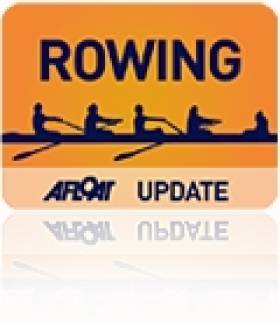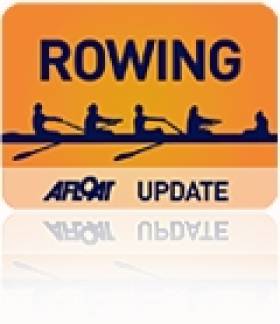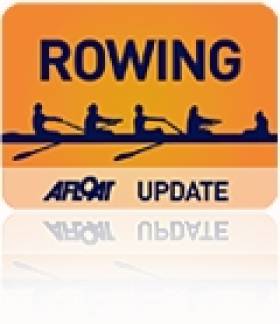Displaying items by tag: Lagan
Trinity Tested in Belfast Boat Races
#ROWING: Trinity won the senior men’s and women’s races at the Lagan Construction University Boat Races in Belfast today. Queen’s closed fast on Trinity coming up to the line in the men’s race and lost by a narrow margin. The senior women’s race was a more decisive win for the visitors, who had a strong senior crew. There was a strong headwind for the 11th annual running of the event.
Lagan Construction University Boat Races, Belfast
Men
Senior: Trinity bt Queen’s, canvas
Fresher: Queen’s bt Trinity
Junior 18, Ulster Schools: Portora bt Bann.
Junior 16 (Craig Cup): Portora bt Methodist College
Alumni: Queen’s bt Trinity, 1 ft
Women
Senior: Trinity bt Queen’s
Fresher: Trinity bt Queen’s, disq
Junior 18 (Bobby Platt Cup); Bann bt Portora
Cork Head of the River Stands Alone as Lagan Event Falls
#ROWING: Lagan Scullers’ Head of the River, scheduled for Saturday in Belfast, has been cancelled. “The forecast was bad and getting worse,” said race director Gordon Reid this afternoon. The weather system could have made the course dangerous. Cork Head, however, is set to go ahead at the Marina on Saturday, with an entry of 280 crews. The high water levels on the Corrib have led to the early cancellation of Galway Head, which was set for St Patrick’s weekend.
Pre-Race Crash Rules Out Queen's at Lagan Head of the River
# ROWING: A collision before the start between the Queen’s University senior eight and the Portadown intermediate four took both crews out of the reckoning at the second head of the day at Lagan Head of the River in Belfast on Saturday. One of the Portadown crew had to be treated in hospital. In the absence of Queen’s, Neptune’s junior 18 eight ruled the waters: they took pennants as fastest crew; fastest junior crew and fastest junior 18 eight. The Belfast Boat Club/RBAI senior crew was the fastest four and Trinity's top women’s senior eight placed well.
| Lagan Head of the River 2013 - Race 2 – 4200m Saturday 16th February at 1500 |
|---|
| RESULTS by Time – Masters handicap not applied |
| POSITION |
| CREW |
| NUMBER Club Class Cox/Steerer Time % of winning |
| time Comments |
| 1 6 Neptune RC MJ18A 8+ H. Thompson 15:59.2 100.00 |
| 2 5 Portora BC MJ18A 8+ E. McClean 16:02.9 100.39 |
| 3 2 CAIBC MJ18A 8+ M. Bucklee 16:03.7 100.48 |
| 4 8 BBC/RBAIRC MS 4- A. Boreham 16:12.1 101.35 |
| 5 21 QUBBC A MN 8+ P. Ramsey 16:36.1 103.85 |
| 6 11 DULBC A WS 8+ G. Nic Fhionnain 16:43.1 104.58 |
| 7 20 BRC MN 8+ K. McCullagh 16:48.2 105.11 |
| 8 13 BBC MM E 8+ A. Scott 17:06.2 106.99 |
| 9 7 LSC MS 4X- P. Cross 17:10.8 107.46 |
| 10 31 Bann RC MJ16 8+ D. Tang 17:11.1 107.50 |
| 11 12 DULBC B WS 8+ N. Williams 17:12.4 107.63 |
| 12 4 RBAIRC MJ18A 8+ R. Hulatt 17:15.8 107.99 |
| 13 22 QUBBC B MN 8+ S. McGaughey 17:27.6 109.21 |
| 14 10 CAIBC/Portora BC MS 4- S. Archibald 17:32.3 109.71 |
| 15 14 BRC/BBC MM E 8+ S. Mairs 17:38.8 110.38 |
| 16 25 BRC MM C 8+ U. Smart 17:54.7 112.05 |
| 17 15 OCBC/Three Castles RC MM F 8+ J. Henry 18:05.4 113.16 |
| 18 27 QUBLBC WI 1 8+ C. Moorehead 18:09.1 113.54 |
| 19 28 Bann RC WI 1 8+ L. Ferguson 18:24.4 115.15 |
| 20 17 CAIBC MI 1 4+ A. Stewart 18:47.7 117.56 |
| 21 23 LVBC MM F 8+ M. Warnock 18:53.3 118.15 |
| 22 40 QULBC A WN 8+ C. Campbell 19:00.2 118.87 |
| 23 37 Portora BC A WJ18A 8+ Z. Donaldson 19:00.5 118.91 |
| 24 24 Bann RC MM C 8+ E. Earl 19:20.1 120.94 |
| 25 42 DULBC A WN 8+ K. Paterson 19:20.9 121.03 |
| 26 32 CAIBC MJ16 8+ A. Stewart 19:26.5 121.61 |
| 27 29 BRC WI 1 8+ E. Catterall 19:42.1 123.24 |
| 28 30 BBC WM D 8+ H. Wilson 19:46.9 123.74 |
| 29 45 DULBC B WN 8+ N. O'Sullivan 20:34.0 128.66 |
| 30 26 BBC/LSC WS 4X- S. Herron 20:54.1 130.75 |
| 31 46 QULBC C WN 8+ M. Toner 20:55.4 130.89 |
| 32 33 Portora BC MJ16 8+ J. Foster 20:57.0 131.05 |
| 33 44 QULBC B WN 8+ A. Espona-McCartney 21:17.2 133.16 |
| 34 36 Portadown BC MM D 8+ R. Walker 22:01.4 137.76 |
| 35 43 Portora BC WN 8+ C. McClean 22:05.7 138.21 |
| 36 35 QUBLBC WS 4- A. Aitken 22:07.6 138.41 |
| 37 39 BRC WM E 8+ S. Smith 22:38.2 141.60 |
| 38 38 Portora BC B WJ18A 8+ E. Reynolds 22:41.3 141.92 |
| 1 QUBBC MS 8+ A. Margret |
| 9 BRC MS 4- C. Coyle |
| 16 QUBBC MI 1 4+ R. Crowley |
| 18 Portadown BC MI 1 4+ L. Chambers |
| 19 BBC WS 4X- L. Cameron |
| 41 UCDBC WN 8+ V. Turner |
| Lagan Head of the River is organised by Belfast Rowing Club |
| with assistance from Queens University Boat Club, Lagan Scullers Club, RBAI |
| Rowing Club and Belfast Boat Club |
| and the following organisations – |
| Belfast Harbour Commissioners |
| Belfast City Centre Regeneration Directorate |
| Odyssey Arena |
| Police Service of Northern Ireland |
| Powerhouse Sport |
Neptune Quadruples Come Out on Top in Lagan Head
# ROWING: Neptune Rowing Club had a good day at the Lagan Head of the River in Belfast on Saturday. Men’s junior quadruple sculls from the Dublin club placed first and second in Head One. Rory O’Connor of Queen’s University was the fastest senior single sculler.
| Lagan Head of the River 2013 - Race 1 – 2700m Saturday 16th February 1130 |
|---|
| RESULTS by Time – Masters handicap not applied |
| POSITION |
| CREW |
| NUMBER Club Class Cox/Steerer Time % of winning |
| time Comments |
| 1 102 Neptune RC MJ18A 4X- W. Doyle 10:59.0 100.00 |
| 2 103 Portora BC MJ18A 4X- K. Anderson 11:21.1 103.35 |
| 3 112 QUBBC A MS 2- C. Beck 11:35.7 105.57 |
| 4 101 RBAIRC A MJ18A 4X- J. Hoy 11:53.7 108.30 |
| 5 155 Portora BC MJ15 8+ E. McClean 11:54.8 108.46 |
| 6 116 QUBBC C MS 2- K. Coughlan 12:01.6 109.51 |
| 7 121 QUBBC D MS 2- J. Cook 12:22.7 112.70 |
| 8 106 RBAIRC B MJ18A 4X- A. George 12:23.8 112.87 |
| 9 110 QUBBC MS 1X R. O'Connor 12:26.6 113.29 |
| 10 147 CAIBC MN 4+ J. Taggart 12:28.7 113.61 |
| 11 119 BRC B MS 2- K. McCracken 12:32.0 114.10 |
| 12 124 BBC B MM E 4+ J. Malloy 12:32.4 114.17 |
| 13 115 Neptune RC MS 2- L. Hawkes 12:32.9 114.24 |
| 14 118 Bann RC MS 2- C. Logan 12:35.3 114.62 |
| 15 150 Portora BC A WJ16 8+ C. McCLean 12:40.0 115.32 |
| 16 108 Bann RC MJ18A 4- M. Curran 12:40.1 115.34 |
| 17 111 LSC MS 1X N. Darby 12:43.7 115.89 |
| 18 135 Portadown BC MN 1X S. McKeown 12:49.1 116.71 |
| 19 156 Bann RC MJ15 4X+ F. Stinson 12:51.0 117.00 |
| 20 140 Commercial RC WI 1 4+ R. Keogh 13:06.1 119.28 |
| 21 123 QUBBC E MS 2- G. Doran 13:10.1 119.90 |
| 22 114 BRC A MS 2- G. Meek 13:11.6 120.12 |
| 23 148 CAIBC MJ18A 2X A. Meenagh 13:11.7 120.13 |
| 24 141 Bann RC WI 1 4+ L. Ferguson 13:16.5 120.86 |
| 25 122 Portora BC MS 2- R. Magwood 13:17.2 120.96 |
| 26 130 SABC MI 1 1X B. O'Carroll 13:18.2 121.12 |
| 27 120 Commercial RC MS 2- S. Connolly 13:21.0 121.55 |
| 28 139 QUBLBC WI 1 4+ C. Moorehead 13:22.4 121.75 |
| 29 145 Portora BC MJ16 4X+ M. Woodhouse 13:24.1 122.01 |
| 30 173 QUBLBC WN 4+ C. Campbell 13:29.6 122.85 |
| 31 161 BRC MN 4X+ S. Smith 13:29.9 122.89 |
| 32 143 Llandaff BC MM D 2- O. Zeigler 13:30.9 123.04 |
| 33 133 Bann RC B MJ18A 1X J. Gordon 13:38.9 124.26 |
| 34 138 DULBC WI 1 4+ N. Williams 13:41.0 124.58 |
| 35 126 Bann RC MI 1 1X D. Whoriskey 13:41.5 124.66 |
| 36 184 Portora BC MM D 1X G. Murphy 13:49.8 125.91 |
| 37 177 DULBC B WN 4+ K. Paterson 13:51.8 126.22 |
| 38 125 BBC A MM E 4+ D. Trainor 13:54.2 126.58 |
| 39 146 RBAIRC MJ16 4X+ D. Taylor 13:54.9 126.69 |
| 40 169 BBC/LSC WM 4X- S. Herron 13:58.5 127.23 |
| 41 178 BRC B WN 4+ K. McCullagh 14:03.7 128.02 |
| 42 136 Neptune RC WJ18A 4X- A. Byrne 14:05.8 128.34 |
| 43 175 BRC A WN 4+ S. Mairs 14:06.1 128.39 |
| 44 160 CAIBC MJ16 2X J. Gregg 14:08.1 128.69 |
| 45 162 Portora BC A WJ15 8+ Z. Donaldson 14:17.2 130.08 |
| 46 181 LSC A MN 1X J. McAllister 14:19.5 130.42 |
| 47 172 DULBC A WN 4+ G. Nic Fhionnain 14:20.4 130.56 |
| 48 105 Portadown BC MJ18A 4X- M. Dowdeswell 14:21.0 130.65 |
| 49 128 CAIBC MI 1 1X C. McDowell 14:22.0 130.81 |
| 50 166 Portora BC WJ18A 1X P. Mulligan 14:22.6 130.89 |
| 51 164 QUBLBC WI 1 1X A. Leahy 14:41.1 133.69 |
| 52 188 BBC MM F 1X S. Lockwood 14:42.4 133.89 |
| 53 185 Neptune RC MM E 1X E. Dolan 14:50.0 135.05 |
| 54 154 QUBLBC B WS 2- A. Aitken 14:57.0 136.12 |
| 55 144 CAIBC MJ16 4X+ A. Moore 15:00.3 136.62 |
| POSITION CREW |
| NUMBER Club Class Cox/Steerer Time % of winning |
| time Comments |
| 56 131 Bann RC A MJ18A 1X M. Curran 15:03.5 137.10 |
| 57 153 QUBLBC A WS 2- H. Douglas 15:19.5 139.53 |
| 58 157 CAIBC MJ15 4X+ R. O'Neill 15:36.9 142.17 |
| 59 193 Portora BC A MJ14 4X+ E. Daly 15:39.9 142.62 |
| 60 191 LSC MM G 2X P. Griffith 15:40.5 142.71 |
| 61 176 BBC WN 4+ A. Scott 15:54.3 144.81 |
| 62 159 Neptune RC WJ18A 2X V. Connolly 16:02.9 146.12 |
| 63 197 BBC WM F 1X A. Lockwood 16:28.9 150.06 |
| 64 151 Portora BC B WJ16 8+ E. Reynolds 16:46.4 152.71 |
| 65 170 BRC WJ16 4X+ M. Taylor 16:47.0 152.81 |
| 66 183 BRC MN 2X T. McAughtrey 16:58.6 154.57 |
| 67 180 Portadown BC MM D 4+ R. Walker 17:06.6 155.79 |
| 68 187 LSC B MM E 1X D. O'Hara 17:24.1 158.43 |
| 69 190 BRC B WN 2X C. Coulter 17:41.6 161.10 |
| 70 198 LSC WN 1X T. Florence 18:05.0 164.64 |
| 71 196 Neptune RC WM B 1X L. Feldman 19:00.8 173.11 |
| 72 195 Portora BC WJ14 4X+ E. Keane 21:13.3 193.21 |
| 73 194 Portora BC B MJ14 4X+ A. Beacom 23:13.6 211.47 |
| p 113 BBC MS 2- A. Boreham |
| 117 BBC/RBAIRC MS 2- J. Mitchell |
| 127 BRC MI 1 1X J. Baird |
| 129 Neptune RC MI 1 1X D. Brett |
| 132 Belfast BC MJ18A 1X Murray |
| 134 De Mass MM C 1X R. Shirley |
| 142 BBC WI 1 4+ A. Clayton |
| 149 Portadown BC MJ18A 2X L. Chambers |
| 163 Portora BC B WJ15 8+ C. Blackwell |
| 165 BBC A WJ18A 1X K. Turner |
| 167 BBC B WJ18A 1X H. McKeever |
| 174 Neptune RC WN 4+ A. Hall |
| 179 BRC C WN 4+ P. Griffith |
| 182 LSC B MN 1X T. McGivern |
| 186 LSC A MM F 1X G. Fettis |
| 189 BRC A WN 2X K. Flack |
| Lagan Head of the River is organised by Belfast Rowing Club |
| with assistance from Queens University Boat Club, Lagan Scullers Club, RBAI |
| Rowing Club and Belfast Boat Club |
| and the following organisations – |
| Belfast Harbour Commissioners |
| Belfast City Centre Regeneration Directorate |
| Odyssey Arena |
| Powerhouse Sport |
Last of National Rowing Heads takes place in Belfast Today
There are 148 crews over the three races starting with pairs and sculls, then doubles and fours and finishing in the afternoon with eights and quads. The third race features 35 eights and 26 quads.
The big race of the day, the men's senior eights, which starts at 3.45 pm, will feature a high intensity race between the two Queen's University eights. The A Queen's crew, with new strokeman, Mike Ewing, have been relatively the same crew for the last three years. This is the crew which mounted serious challenges to the victorious NUIG team at the Irish Rowing Championships, narrowly missing out on a national senior eight by a mere few feet on two occasions. The A team's Ewing won a Wyfold cup (men's coxless four) at Henley last year.
The women's intermediate eights should prove interesting with a crew entered from St Andrews in Scotland who will be up against Queen's University Ladies and St Michael's, Limerick.
The men's junior 16 eights sees all the Ulster crews up against each other whilst the men's junior 18 quads sees Blackrock College, Dublin, Shandon ,Limerick and Offaly Rowing Club take on the Ulster schools.
Eight crews will contest the men's Master's pennant (over 28s) with Galway, Bann and Athlone pushing the Belfast-based masters crews, Belfast Boat Club, Belfast Rowing Club and the Lady Victoria Boat Club, all the way. The former Queen's ladies rower ,Frenchwoman Solange Garrais is bringing a men's Masters and a women's Masters quad from Aviron Grenoblois, France to compete.
The 10.45 am and 13.15 pm races start at the Albert Bridge in Belfast and finish at Queen's boathouse at Stranmillis. The 15.45 pm race starts at the Odyssey building in Belfast Harbour and finishes at Queen's boathouse at Stranmillis. There are viewing points along the full length of each race.
The official start to the regatta season takes place on Saturday 2nd April with the Neptune regatta at Islandbridge, Dublin.
Click this link for Irish Rowing detailsClick this link for the Latest Rowing News

































































